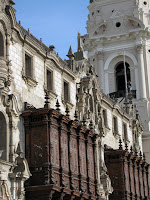AFTER
sitting on 49 countries for the better part of a year I've finally added a 50th
destination to the list of places I’ve been.
I’m
in Peru for a couple of weeks, on an expedition organised by LAN Airlines and
Adventure World, and starting this visit with a day in Lima to get used to the
altitude before continuing up to Arequipa and the Colca Canyon.
Lima
– which, I’m told, is called the Garden City of the Pacific – is a former
colonial outpost once surrounded by a very solid wall because the Spanish
settlers were afraid of getting attached by the natives or pirates invading
from the sea.
The Plaza de Armas, or the Plaza Mayor which is the big square at the heart of colonial Lima and the place locals gather when they want to demonstrate about something, is flanked by the La Cathedral de Lima and the Palacio de Gobierno as well as a collection of elegant Spanish buildings.
The Plaza de Armas, or the Plaza Mayor which is the big square at the heart of colonial Lima and the place locals gather when they want to demonstrate about something, is flanked by the La Cathedral de Lima and the Palacio de Gobierno as well as a collection of elegant Spanish buildings.
Our
guide for the afternoon pointed out the beautiful balconies decorating the
upper levels of some of the old homes around the square, explaining the
covered vantage points were put in places so locals could sit and gaze down on
the crowds without being seen by those in the plaza below.
"These are historic Moorish and Spanish balconies that are wood and
decorated with beautiful carving," our guide said.
"The richest people put them on their homes
because they wanted to keep an eye on things without people looking at them
relaxing."
We
started our tour of Lima’s Colonial Quarter at the Monasterio De San Francisco,
the bright yellow sanctuary famous for its "bone-lined catacombs and
remarkable library", and spent a couple of hours wandering the dark and quiet
rooms.
The
walls of the shady arcades were decorated with tiles handmade in Spain during
the 1600s, an enviable collection of religious art adorned the rooms
surrounding the cloisters, and the bricks were made from the whites of seabird
eggs.
"Much
of the art comes from the Flemish painters that were members of the Reuben’s
school," our guide explained.
"You
can see the techniques of light and shadows that were eventually adopted by the
Peruvian artists of the era, and there are lots of children in the scenes
because they were a symbol of innocence and fidelity during the 17th
century.
"There’s
a painting of the Last Supper in one of the old chapels that’s a tribute to
Indian culture, with a guinea pig on the menu and lots of chili on the table,
and it’s one of the few works of the event that show Jesus and the Apostles
sitting at a round table.
"This
was painted after that particular artist had been over the mountains, had made a
journey across the Andes and learnt more about the Indian culture."
The
complex is also home to Lima’s catacombs, with the early Catholics buried under
the church rather than outside the city walls, and experts think there’s
between 20,000 and 30,000 people buried in the connected subterranean spaces.
"This
is where the commoners were buried, and the rich were buried somewhere else
because the wealthy families could afford to built crypts," our guide noted as
we explored the subterranean chambers.
"The
catacombs are still used, but only priests can be buried here now."
There
are 43 suburbs in Lima, with 9 million people living in the crowded metropolis,
and we could see one of the many shanty towns that surround the Colonial
Quarter as we waited to cross the street outside the Monasterio De San
Francisco.
The
colourful dwellings were just simple concrete boxes, with a couple of levels
and some small square windows, and this poor neighbourhood was clinging to the
side of a mountain only a couple of kilometres from the heart of the capital.















